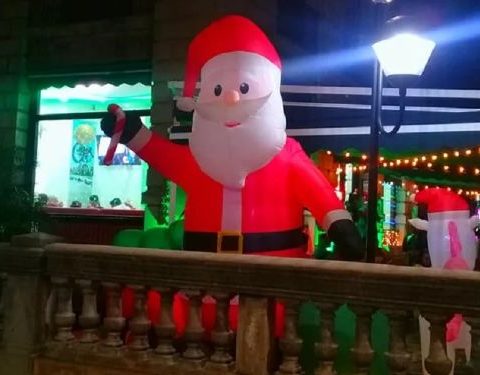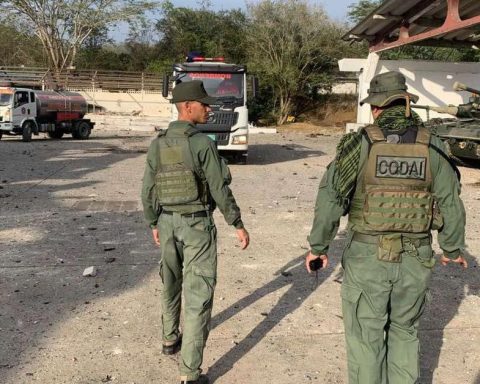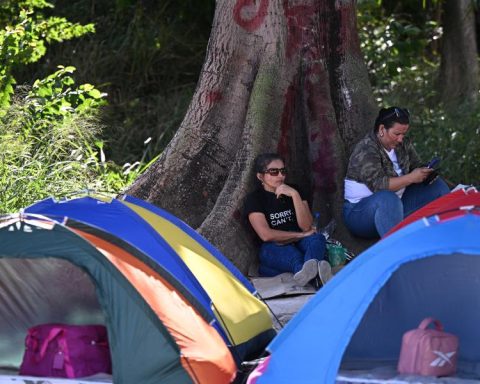On occasions, the experience that age brings is added to the contemporary consecration for artists who continue to create and are references, such as Louis Philippe Noah with his paintings and books, Julio Le Parc with his works and Marta Minujin with his new arrival at the MoMa in New York and the achievement of an honorary doctorate just awarded by the Di Tella University. They are “outstanding personalities” for whom recognition in life constitutes “a sign of maturity of a society,” says Andrés Duprat, director of the Museum of Fine Arts, where these three artists have had recent recognition.
In a recent scene in early November, Noé and Minujin posed for attentive cameras in front of the new “Yuyo” paintings exhibited at Arteba, the annual art fair that two weeks ago celebrated its 30th birthday in La Boca.
Both artists are almost icons Indispensable of the artistic system, not only because of their trajectories and international projection, but also because of the affection they arouse and the admiration of their works and personalities. This is also the case of Le Parc, the Argentine artist living in France for more than five decades to whom important retrospectives have been dedicated in recent years at the Kirchner Cultural Center and the National Museum of Fine Arts (MNBA).
“The recognition in life of an outstanding personality in art or science implies a sign of maturity of society before all those who had a late one -explains Télam Andres Duprat, director of the Fine Arts-. There are too many examples in history of avant-garde characters who lived a miserable life, or were persecuted or ignored and who, after their death, were valued and vindicated. “

“One of the lines of work that we carry out at the Museum has to do precisely with being attentive to our older artists and, aware of the importance of our institution, recognizing their work through exhibitions, tributes or awards,” explains Duprat.
In recent years, numerous exhibitions of relevant artists in activity have been held in this space, among which are Norberto Gómez, Le Parc, Diana Dowek, Noé, Carlos Alonso, Guillermo Roux and César Paternosto.
For Duprat, these personalities, in addition to his work, “operate as references that stimulate the art scene”; a scene that is not “a sum of individualities” but conceives it “as a field of collective creation, absolutely synergistic and connected”. And in it, these references “open paths for subsequent generations and are a palpable manifestation that it is possible to transcend and leave an imprint and a legacy,” he reflects.


Can we consider these artists as exponents of Argentine art? “Talking about nationalities in contemporary art productions may be anachronistic. But although both the work of Minujín and that of Le Parc and Noé are based on formal and conceptual searches of a universal nature, or at least Western, there is a A profoundly Argentine point of view in Noé’s approach to chaos theory, Minujín to sensible experience and Le Parc to the study of light, color and movement “, analyzes Duprat.
Le Parc lived most of his life in Paris – says the director of the Fine Arts – while Minujín and Noé They had long periods in Paris and New York and there they were nourished by global trends, but the three were formed in Argentina from where they built their gaze and their original and avant-garde voice that crossed time. If, as Rainer María Rilke wrote, the true homeland is childhood, I believe that we carry that fate all our lives, no matter where we live, “he says.
And it lists other relevant artists such as Antonio Seguí, Liliana Porter, Leandro Katz or David Lamelas, “who, even living in other latitudes for decades, have a work with a strong Argentine imprint”, as in literature are Julio Cortázar, Juan Rodolfo Wilcock or Juan José Saer, who living abroad “are exponents and references of culture.”

Perhaps, the famous expression of Minujin “Art, art, art” remains as a mantra repeated ad nauseam, as motivation, or is completed with his various works and his sensitivity, which resulted during 2020 in the work “Pandemia”, which with its 26,000 strips glued on canvas was exhibited this year at the MNBA, or its fluorine colors in the installation “Implosión” more recently in Buenos Aires; as well as the London tower of Big Ben lying down at the Manchester International Festival – from his series “Bedding the myths” (to give rise to new ones) – or the preferential space at the MoMA in New York. And, although the awarding of an honorary doctorate by the Di Tella University seals a stage in his life as an artist in his renowned passage through the famous homonymous Institute in the 1960s, it does not close it.
In a different key, Le Parc said in a recent interview: “I never place much emphasis on the category of artist. I have always been doing things, experimenting, rehearsing, playing, having fun or not, in order to get closer to the viewer.”
The museum dedicated the exhibition “Transition Buenos Aires-Paris (1955-1959)” to him in parallel to the retrospective at the Kirchner Cultural Center (CCK) in 2019. In this cultural center, since 2015 there is his “Blue Sphere”, a work from the series that incorporates the exterior elements – air and reflections – and that comes from developments in the 60s on instability with the idea of what it is and at the same time it is changing.
During the global pandemic, and the Parisian “confinement”, the video “Julito confinado” made by his son released an “Always Optimist” while showing an active artist in his habitat.
A benchmark of international optical and kinetic art, also during the pandemic Le Parc (Mendoza, 1928) installed a large mobile in the Tabakalera of San Sebastián (Spain) called ‘Kuboa’: a work of 10 meters in perimeter, and a ton of weight composed of 2,660 stainless steel parts.
And he recently had his first solo show in Japan with “Les Couleurs en Jeu” (“Colors at stake”), at the Hermes Foundation’s Le Forum art space located in the Ginza district, in the heart of Tokyo.
At 92 years old and living in France since 1958, the artist was inspired by Piet Mondrian and the Russian Constructivist movement. Le Parc uses geometric abstraction like colors “to challenge the traditional role of art as something appreciated by the elite and passively consumed.”

On the other hand, Luis Felipe “Yuyo” Noé (Buenos Aires, 1933) reinforced his pictorial and literary work during the pandemic with his now traditional end-of-year shows at the Rubbers gallery, and the publications of “Art between technology and rebellion” (2020) -which waited 50 years to be published- and the new edition of his novel “Puzzle Codex on Recontrapoder en cajón disaster”, and the staging of his installation “Entreveros” in the Muntref, while he continues to be motivated with another work that reveals it: the book “La asunción del chaos”.
Part of the group “Nueva figuración”, which had its tributes at the National Museum of Fine Arts this year, Noé says: “The theme is always the same. My theme is to pinch something of that great whole that surpasses us, which is what I call chaos “, because” life is chaos “.
“I am producing and above all, I am 88 years old, I am not afraid of death but I am afraid of death in life, so I have to try to specify all the things that I want to do,” he also stated in dialogue with Télam on occasion of his new show “Time without age”:
In 2017, the Fine Arts dedicated the exhibition “Luis Felipe Noé. Prospective look” to him, a 60-year journey through his works with an accent on the “aesthetics of chaos”.
Also on these days is available, at the Mar del Plata Festival with online and free viewing, “Tres en la deriva del act creativo”, by the filmmaker Fernando “Pino” Solanas, who died last year in Paris. The posthumous documentary brings together three referents of art: Noé, the playwright and actor Eduardo “Tato” Pavlovsky and the filmmaker himself. The film is accompanied by the homonymous cycle with conversations and the exhibition of the installation “Coherente oxymoron” (2014) by Noé at the CKK.
So, in order not to have pending accounts, it is necessary to be attentive to “our artistic environment” as “a continuous task of sensitivity, readings, study, contextualization and reflection”, because “you cannot assess what is not known”, he clarifies. the Duprat.
“The recognition of an artist and his work can come from different places, from the academy, institutions, other artists, critics or the general public.” And in the particularity of Argentina in attention to the “plurality and heterogeneity, one of the pending accounts is the recognition and visibility of artists from the provinces who have a poetics that responds to a different canon from the one that prevails in Buenos Aires,” he concludes.
Part of the recognition to the artists is part of the Lifetime Achievement Awards organized annually by the Ministry of Culture from the Palais de Glace, lifetime pensions are granted “to eight of the most outstanding plastic artists in the country, whose works become part of the collection of the MNBA, “including Noé and Minujin.
Le Parc, Noé and Minujin share, among other things, another type of link between work and viewer, although the place of the artist and his practice is not the same, as well as a departure from the two-dimensional as an experience, and above all an incessant activity.


















